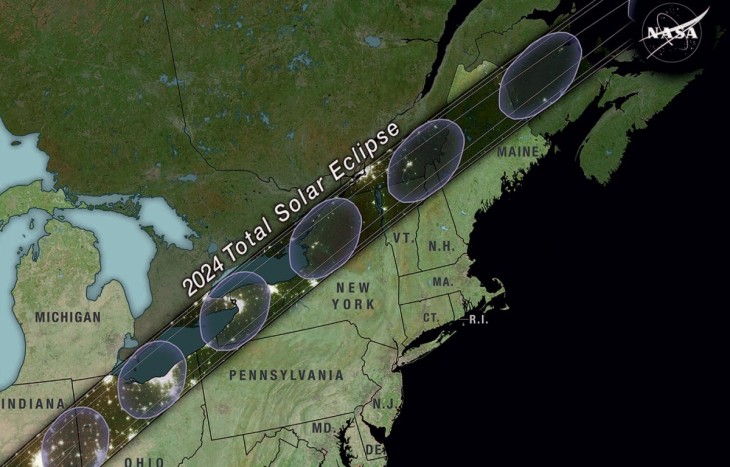
April 2024 presents an opportunity to experience two rare and spectacular astronomical sightings in northern New England. A total solar eclipse will occur for the first time in our region since 1932, and the comet called 12p/ Pons-Brooks will also be visible during the month, as it makes its approach to the sun after an absence of 70 years.
On April 8, thousands of people will descend on places in the path of eclipse totality – locations where the moon fully obscures the solar disc as it passes between Earth and the sun. Some communities and science centers are planning big celebrations for this astronomical double-header. For example, Fairbanks Museum & Planetarium in St. Johnsbury, Vermont, will feature educational programs and a live video from NASA, plus play-by-play action with Planetarium Director Mark Breen and Vermont Public’s Jane Lindholm, host of But Why: A Podcast for Curious Kids.
During the solar eclipse, the moon will cast a 100-mile-wide shadow that moves along the path of totality, beginning in Mexico and progressing northeasterly across North America, reaching Texas at 1:27 p.m. Central Daylight Time and leaving the coast of Newfoundland, Canada at 5:11 p.m. Newfoundland Daylight Time. The eclipse maximum (when the moon blocks the largest portion of the sun’s disc) will last about 4 minutes in each location as it crosses the Northeast, starting at approximately 3:15 p.m. Eastern Daylight Time in Erie, Pennsylvania, 3:25 p.m. in Burlington, Vermont, and at 3:33 p.m. in Caribou, Maine.
We can only see the sun’s reddish chromosphere and the corona’s whitish streamers during a total solar eclipse. But the sun’s energy can still damage eyes and cause blindness, so don’t ever look directly at the sun, even during an eclipse. For guidance on safe viewing, including indirect viewing techniques and the option of wearing eclipse glasses (which are not the same thing as sunglasses), go to this NASA link.
As for the comet 12p/Pons-Brooks, the best time to see it is in the early evening sky during the first two weeks of April, as it passes through the constellation Aries above the western horizon. Take a good look because it won’t appear again until 2095! The comet will disappear below the horizon during the third week (date dependent on your specific location), prior to reaching its perihelion (the point at which it’s nearest to the sun) on April 21.
Comet 12p/Pons-Brooks is named after two men: Jean-Louis Pons, who discovered it in 1812, and William Robert Brooks, the astronomer who rediscovered it in 1883. It becomes visible at 71-year intervals when its elliptical solar orbit brings it close to Earth. At its closest approach to Earth on June 2, 2024, it will be 144 million miles away and traveling at a speed of more than 100,000 miles per hour. At roughly 10½ miles across, this icy colossus is bigger than Mount Everest.
Ephemeral sightings, comets get their name from the Greek kom ˉet ˉes, meaning “long-haired” and the Latin cometa, for “hair.” In ancient times, these celestial visitors were considered signs from the gods, and often portents of plague, ruin, and the downfall of dynasties. Those who suffered, however, could drown their sorrows with a glass of “comet wine,” the supposedly superior vintages made from grapes grown under comets’ influences.
Comets are composed of dust and rock particles mixed with other frozen elements, including water, carbon dioxide, carbon monoxide, ammonia, and methane. Solar radiation heats the solid elements of a comet’s surface as it approaches the sun, transforming them into a gaseous, glowing plume called a coma that spreads out into space on the side facing away from the sun. In the case of Comet 12p/ Pons-Brooks, the sun’s radiation superheats the comet’s core until the subsurface ices vaporize, building up tremendous pressure, and causing these compounds from the core to erupt violently into space from a cryovolcano. One region of the comet’s shell may have a thickening or notch that does not rupture, forcing two plumes of material into space from either side of this zone. The comet’s frequent releases of gas, ice, and dust into twin, horn like projections have earned it the name Devil Comet, and more recently, Millennium Falcon Comet due to its resemblance to Han Solo’s starship of the Star Wars saga.
Amazingly, comets are thought to contain matter that dates back to the formation of the solar system. Fascinating astronomical phenomena by any measure, they offer insights into the nature of the universe itself.


